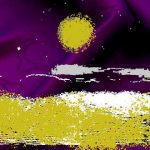“The Orient is not only adjacent to Europe; it is also the place of Europe’s greatest and richest and oldest colonies, the source of its civilizations and languages, its cultural contestant, and one of its deepest and most recurring images of the Other. In addition, the Orient has helped to define Europe (or the West) as its contrasting image, idea, personality, experience. Yet none of this Orient is merely imaginative. The Orient is an integral part of European material civilization and culture. . .”
(Orientalism. New York: Vintage, 1979, 1-3,5.)
The Orient, in the Eurocentric ideologies, is everything that Europe or the ‘Occident’ is not, it is ignorant when the Occident is knowledgeable; through the different acts of reformation it went through over the time. It is barbaric, where the Occident is civilised, it is dark where the Occident is light, it is the Other, where the Occident is the Self; the different, exotic place, where the people do not follow the “Law of the Jungle”. Thus, the burden to “civilize” the wild East fell upon the head of the Europeans, and the Orients never got a say in it. Kipling aptly termed it as the White Man’s Burden, and that burden is still heavy upon their shoulders, even though the Orient never asked them to carry it. The Occident failed to realise that “civilization” is a relative term, and they do not get to define it.
European countries have had relations with the East for many a millennia, and with the advent of colonialism, these relations only solidified. Many artists, historians and writers depicted the East in their respective works and over the period of time, those ideas became the West’s perspective of the East. Thereby, Africa became the continent of black cannibals, India the country of snake-charmers, China became the land of Kung Fu and chopsticks, and the Middle East the land of Muslims and terrorists. The countless Asian and African cultures solidified into a single term-The Orient.
These stereotypes, that were created so long ago still hold true for many westerners, who specifically visit the East to experience their exotic cultural. They are further reinforced by the modern media who, through the medium of pop culture, freezes these ideas and develops new ones as well. One such example of this is Disney’s hit 1992 animated movie, Aladdin.
Aladdin
Story-telling is a way of conveying ideologies to individuals, and Disney is the master storyteller. The Grimm Brother’s “Adventures of Aladdin” movie adaptation opens with the song “Arabian Night” starring an overly “arabic” man, with an arabic accent. He sets up the storyline for Aladdin, while trying to trick some customer to buy the supposedly “mysterious” lamp. He is wearing a large turban and the characteristic beard and mustache that the pop culture is so fond of depicting the Arab men in. And since the stereotyping is just beginning, the song itself contains words that gives it the distinct orient flavor, the Other-ness.
Oh, I come from a land, from a faraway place
Where the caravan camels roam
Where they cut off your ear
If they don’t like your face
It’s barbaric, but hey, it’s home!
(Arabian Nights, Aladdin)
The third and the forth lines were later changed to “Where it’s flat and immense/And the heat is intense” upon seeing the agitation of the American muslims. The word “barbaric” the signifier of the wild East, however, still made it through. The Orient might be “barbaric” but they are still happy to call it “home” and live in their present conditions, however bad they might be. Until their salvation in the form of the White Men comes and liberate them from themselves, put on their “White Men’s burden” of civilizing the whole world.
Throughout the movie, most of the women, including the Princess Jasmine herself, are scantily dressed, in the costume of belly dancers feeding the image of Arabian women as harem dwelling seductresses. While it may be argues that most of these women are harem dwelling prostitutes, it still does not explain why a conservative society, such as that of Agrabah that makes the women veil their faces, is fine with their princess dressed similarly to those of the prostitutes of the previous scene.
Jafar is the only character, other than the swarthy and violent palace guards, who has a somewhat arabic accent although a scary “villian-like” voice. However, Aladdin, Jasmine, the King, Genie, and the animals talk in a distinctive American accent, to connect better with the audience. Through this practice, whether knowingly or unknowingly, the filmmakers are giving the impression that all arabic men are bad men ruffians who have absurdly large noses, long beards and mean expressions, a stereotype that is the cause for rising Islamophobia.
The character of the Genie is a distinct example of the European gaze, the filter through which they see the Orient. According to the Qur’an, God created the jinn out of the “fire of a scorching wind”. They are the evil creatures entrapped in bottles and are very cunning, the eastern counterpart of the trickster. The filmmakers know what the genie was, thanks to the widely read and loosely translated The Arabian Nights but not its significance in their lore, so they make a completely westernized version of him. Even in “The Adventures of Aladdin” the Jinn becomes the Genie but its Arabian essence and the aura of a powerful being somehow makes it to the last word. The Jinn who was once God’s greatest creation before the humankind is metamorphosed into a sadder although quite quirky version of himself, who impersonates the western talk show hosts and other famous personalities. The element of magic also gives it the much needed “exotic” and “mystical” touch, important for the ‘Orient’ tag. The film combines various cultures of the east to form the Orient, like making the Agraba palace appear like Taj Mahal, and the Indian name of Jasmine’s pet (Rajah), who happens to be a Tiger.
The Lion King
The movie, The Lion King is one of Disney’s highest grossing films of all times. The setting and the characters are very children friendly, with beautiful rican forests and talking animals, but the idea behind it is. It is closely related and influenced by Shakespeare’s Hamlet, where Simba’s father, just like Hamlet’s, is killed by his uncle and later his chest haunts them to take revenge. Since Shakespeare himself was a white man living in the colonial England, some of his supremacist beliefs are bound to reflect here as well.
The ingrained orientalism lies in the over emphasis on the “circle of life”, a natural fixed social order, which if disrupted, will lead to chaos and violence. Mufasa uses this claim to justify the animal kingdom’s predatory nature “Yes Simba and when be die over bodies will turn to grass and the antelope eat grass”. Samba is baptized into the feudal class, here the actions and merits doesn’t matter. No chance of rising the social order for those who aren’t already at the top (all animals except the lions and Rafiki). Hence when Rafiki shows off the cub Simba to the rest of the animals, it is a clear that the animals should be afraid that he might kill them, but should alaso be joyful because he will be their future king, sending a very clear message to the animals to know their place. It is only through subjugation that animals can find their place in the world, and thereby find peace. Much like Socrates concept of the Nobel lie which his disciple, Plato mentions in the New Republik, that if humans were told that God sprinkled gold in the souls of the important people,and less precious metals in everyone else’s they would be happy to except their lot in life because they have been ordained from on high, a concept that was highly useful to the Europeans during the colonization period, to exert their “rightful” claim over the Orients.
The only one who rejects this feudal society is Scar (“we shall rise”) who is also the only one with an English name and bears a scar literally as well, perhaps due to a head wound, leaving him deranged and hence a rebel to the peaceful, natural order. He rebels against the natural societal order that labels him to be a weakling just cause he doesn’t have the golden fur and the luscious mane like that of Mufasa, once again alluding to the various claims that the Europeans exerted on the East. Scar’s mane is darkish to the golden mane of Mufasa, playing with the light of the friend in the dark continent card, which makes the Other among the other lions. When, with tricks and wickedness he does come to power, he brings about an era of equality, allowing the hyenas, who are the natives because of their large population and their stupid and uncivilized acts, to be on equal footing with the lions. But despite his progressive politics, he’s not really altruistic, because according to the occidental belief, the East lack the power to rule itself and thereby must be governed by the West. His song about ushering in a new world order features a nazi marching imagery, and just like Adolf Hitler, his reign soon turns sour because interference with the natural order of the food chain, a once prosperous utopia changes into anarchy and starvation.
Mufasa: Look, Simba. Everything the light touches is our kingdom.
Simba: But, what about that shadowy place?
Mufasa: That’s beyond our borders. You must never go there, Simba.
The occidental curiosity to visit The Elephant Graveyard, which is located in the ‘shadowy place’, is something that can be alluded to the magical elements of many post-colonial writers, where Light is the Occident and its binary opposite id the Shadow. It also alludes to Africa, where Pride land is actually situated, to being a Dark Continent. Thereby, Scar is placed in dark and shadowy areas, using shadows as the pathetic fallacy to demonstrate the warn of the future that lies ahead.
Orientalism is still quite evident in many popular movies created even in the postmodern world, and although it is not as noticeable now as it was in the earlier movies, people are growing up believing the stereotypical ideas of their older family members reinforced by these subtle but sure stereotyping. It is important to shed this view of the eastern world and see it as it is, an amalgamation of different cultures and complex structure, and not to just simplify it as another third-world nation or an Orient.
Work Cited
“Adventures of Aladdin”. Brothers Grimm Fairytales. Web. 2 Mar. 2017.
Aladdin and the Magical Lamp. Web. 2 Mar. 2017
Said, Edward W. Orientalism. New York: Vintage Books, 1979. Print.
Clements, Ron and John Musker dir. Aladdin. Written by Roger Allens and Ron Clements. Walt Disney Pictures, 1992.
Allers, Roger and Rob Minkoff dir. The Lion King. Written by Irene Mecchi, Jonathan Roberts and Linda Woolverton. Walt Disney Pictures, 1994.
Shmoop Editorial Team. “Postcolonial Theory Texts – Orientalism by Edward Said (1978).” Shmoop. Shmoop University, Inc., 11 Nov. 2008. Web. 12 Mar. 2017.
“Disney Lyrics.” Available: http://www.geocities.com/disneywonders/Lyrics.html. Web 15 March 2017.
“The Lion King: A Retrospective Of Post Colonial Criticism”. NNZ’s Nerd Talk. Web. 10 March 2017
Borthaiser, Nóra ““A Whole New World(?)” – Rereading Disney Animations Of The Early 1990” By Nóra Borthaiser” Americana E-Journal Of American Studies In Hungary. Web. 15 March 2017.
Orientalism in Disney Movies
Aladdin
Story-telling is a way of conveying ideologies to individuals, and Disney is the master storyteller. The Grimm Brother’s “Adventures of Aladdin” movie adaptation opens with the song “Arabian Night” starring an overly “arabic” man, with an arabic accent. He sets up the storyline for Aladdin, while trying to trick some customer to buy the supposedly “mysterious” lamp. He is wearing a large turban and the characteristic beard and mustache that the pop culture is so fond of depicting the Arab men in. And since the stereotyping is just beginning, the song itself contains words that gives it the distinct orient flavor, the Other-ness.
Oh, I come from a land, from a faraway place
Where the caravan camels roam
Where they cut off your ear
If they don’t like your face
It’s barbaric, but hey, it’s home!
( Arabian Nights, Aladdin)
The third and the forth lines were later changed to “Where it’s flat and immense/And the heat is intense” upon seeing the agitation of the American muslims. The word “barbaric” the signifier of the wild East, however, still made it through. The Orient might be “barbaric” but they are still happy to call it “home” and live in their present conditions, however bad they might be. Until their salvation in the form of the White Men comes and liberate them from themselves, put on their “White Men’s burden” of civilizing the whole world.
Arnima is an aspiring writer and a literature student.






Leave a Reply